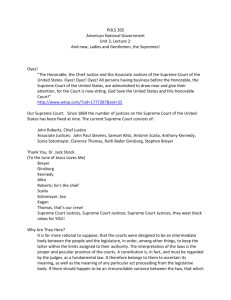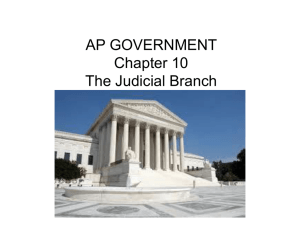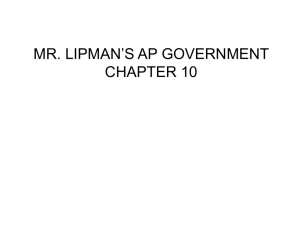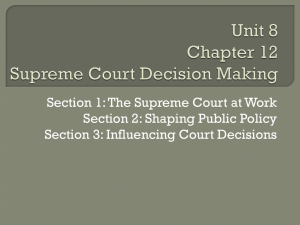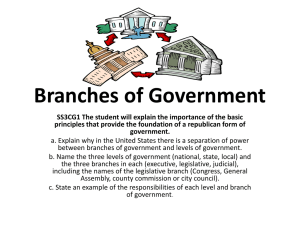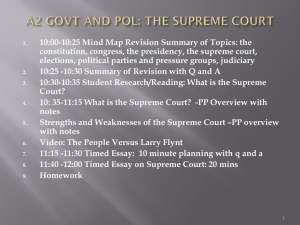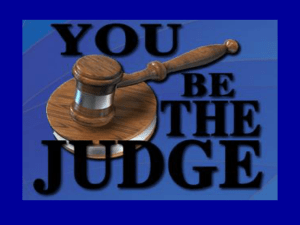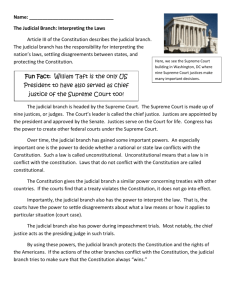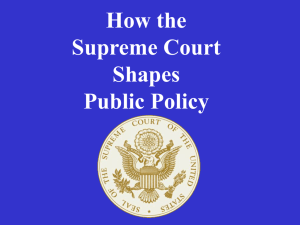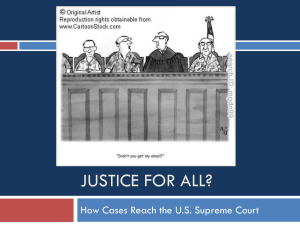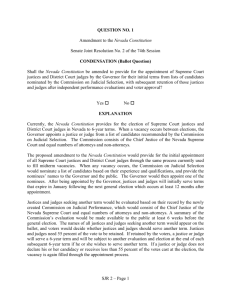Judicial Independence
advertisement
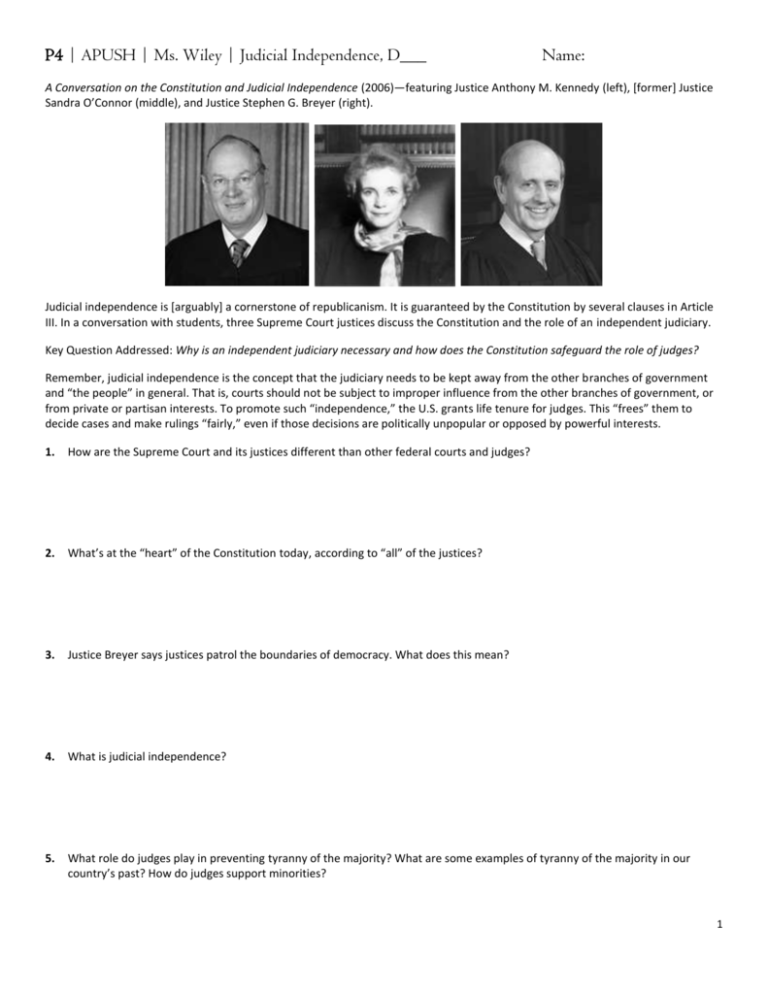
P4 | APUSH | Ms. Wiley | Judicial Independence, D___ Name: A Conversation on the Constitution and Judicial Independence (2006)—featuring Justice Anthony M. Kennedy (left), [former] Justice Sandra O’Connor (middle), and Justice Stephen G. Breyer (right). Judicial independence is [arguably] a cornerstone of republicanism. It is guaranteed by the Constitution by several clauses in Article III. In a conversation with students, three Supreme Court justices discuss the Constitution and the role of an independent judiciary. Key Question Addressed: Why is an independent judiciary necessary and how does the Constitution safeguard the role of judges? Remember, judicial independence is the concept that the judiciary needs to be kept away from the other branches of government and “the people” in general. That is, courts should not be subject to improper influence from the other branches of government, or from private or partisan interests. To promote such “independence,” the U.S. grants life tenure for judges. This “frees” them to decide cases and make rulings “fairly,” even if those decisions are politically unpopular or opposed by powerful interests. 1. How are the Supreme Court and its justices different than other federal courts and judges? 2. What’s at the “heart” of the Constitution today, according to “all” of the justices? 3. Justice Breyer says justices patrol the boundaries of democracy. What does this mean? 4. What is judicial independence? 5. What role do judges play in preventing tyranny of the majority? What are some examples of tyranny of the majority in our country’s past? How do judges support minorities? 1 6. Judges have the potential to make unpopular decisions. Provide an example and explain how this ties into the concept of judicial independence. 7. How is the Supreme Court “checked” by the other branches of government? Lower courts? 8. How is judicial independence protected? 9. What does Justice Breyer say is different about the judges in Russia and the judges in America? 10. Explain the metaphor Justice Kennedy makes about the U.S. government. What does he mean when he says the Constitution/government is “not automatic”? 11. How does the judicial branch differ from the other two branches? What do they have to “wait” for, which the other branches do not? 12. How are state court judges different from federal judges? How does Justice O’Connor feel about the partisan elections for state court judges that occur in most states? 13. How did President Jackson ignore a Supreme Court decision? How did President Eisenhower enforce a Supreme Court decision? Jackson Eisenhower 14. Justice Kennedy talks directly about our course theme, American and national identities! What does he say? 2 15. What are the greatest threats to judicial independence? Post-Viewing Questions: 16. What is your reaction to these three Supreme Court judges? Their answers? Their demeanor? Which was your favorite? Why? 17. What is the most important thing you learned about the Supreme Court or the judicial branch from watching this video? Life Tenure is Too Long for Supreme Court Justices, Atlantic Magazine, by Stuart Taylor Jr., 2005. Allowing Supreme Court justices to serve for life is causing too many problems. It's time to consider setting 18-year term limits for all future justices. "The Judges, both of the supreme and inferior Courts, shall hold their Offices during good Behaviour...." —U.S. Constitution, Article III, Section 1. That seemed a good idea at the time. The Framers wanted to make the Supreme Court and lower federal courts independent of the political branches and insulate them from popular passions. What better way than to give them life tenure? James Madison, Alexander Hamilton, and company had little occasion to ponder the possibility that one day most justices would serve longer than your average medieval monarch. The 10 who have retired since 1970 have averaged 25 years on the Court. . . . By contrast, the first 10 justices served an average of under eight years, in part because of the rigors of the "riding circuit" that covered hundreds of miles on horseback. Three left to take other positions. Only two lived to age 70. The 90 justices who had completed their terms by 1970 retired (on average) after 15 years on the bench, at age 68. Thus, modern medicine and other societal changes have transformed the meaning of life tenure. This longevity has contributed to some serious problems, according to an ideologically diverse group of 45 leading legal scholars, several of whom are publishing law review articles on the subject. Earlier this year, these scholars agreed "in principle" on a proposal that seems especially timely now: staggered, 18-year term limits for all future justices, to marry judicial independence with more frequent and regular injections of new blood by the president and the Senate. The problems associated with life tenure are subtle but serious: [some are excerpted here:] Decrepitude. Some justices have remained on the Court until mentally debilitated or, at best, long past their prime. There will be more, given our increasing ability to keep people alive long past the point of mental incompetence. William Douglas, who set the record for Supreme Court tenure (almost 37 years), barely functioned during his last 10 months, after a debilitating stroke in 1975; colleagues informally agreed to nullify any decision in which Douglas cast the deciding vote. Hugo Black and Thurgood Marshall were shadows of their former selves years before retiring, at 85 and 83, respectively. "I'm getting old and falling apart," said Marshall on his last day. Hubristic complacency. If power corrupts, life-tenured power corrupts more completely. The justices' vast power "carries dangers of arrogance, hubris, and abuse," in the words of a paper prepared by the two leading advocates of the 18-year termlimit proposal. "The Founders could not foresee that increases in longevity would imperil the rotation in powerful office essential to representative government," the paper added. The authors are Paul Carrington and Roger Cramton, professors and former deans of the Duke and Cornell law schools, respectively. (Carrington is a Democrat; Cramton, a Republican.) Unaccountability. By making new appointments less frequent, longer tenure has diminished the abilities of presidents and senators to provide the only form of democratic accountability that is consistent with judicial independence. The average time between appointments has nearly doubled from 1.7 years before 1970 to 3.3 years since, with no appointments since 1994. 3 Randomness. Filling Supreme Court vacancies is a cardinal presidential power. But life tenure leaves each president's allotment to chance, skewed by individual justices' efforts to hang on so as to thwart the ambitions of presidents they don't like. Richard Nixon chose four justices in his first term; Jimmy Carter chose none. Uglier confirmation battles. Slower turnover has raised the stakes on each new appointment so high as to make confirmation battles even more intense than they would otherwise be. Conservatives hope, and liberals fear, that President Bush may lock in a young, conservative majority that could revolutionize constitutional law for 20 to 40 years. Small wonder that confirmation proceedings have acquired the ugliest, most demagogic trappings of presidential campaigns. . . . Supreme Court justices take a three-month summer recess and seven weeks of winter recesses, convene on only about 80 days per year, and have the very brightest of law clerks to do most of their work. Justice Sandra Day O'Connor, for one, obtained reimbursement for 28 trips in 2004 alone, including travels to England, France, and Austria, and published books in both 2002 and 2003. . . . None of this is to deny that some very old, very senior justices have remained very sharp. Oliver Wendell Holmes Jr. was 90, and had 28 years on the Court under his belt, when at the sight of a pretty girl he exclaimed, "Oh, to be 70 again!" May all of our justices live—but not rule—as long as Holmes. 18. What were Taylor’s most convincing arguments? Least convincing? 19. Do you agree with Taylor’s main point? Why or why not? 20. How do you suspect the founders might respond? Back row: Sonia Sotomayor; Stephen G. Breyer; Samuel Anthony Alito, Jr.; Elena Kagan Front row: Clarence Thomas; Antonin Scalia; John G. Roberts, Jr. (Chief Justice); Anthony M. Kennedy; Ruth Bader Ginsburg 4
